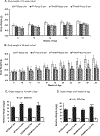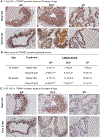Gene expression signatures associated with suppression of TRAMP prostate carcinogenesis by a kavalactone-rich Kava fraction
- PMID: 26840761
- PMCID: PMC6518389
- DOI: 10.1002/mc.22469
Gene expression signatures associated with suppression of TRAMP prostate carcinogenesis by a kavalactone-rich Kava fraction
Abstract
Kava (Piper methysticum Forster) extract and its major kavalactones have been shown to block chemically induced lung tumor initiation in mouse models. Here we evaluated the chemopreventive effect of a kavalactone-rich Kava fraction B (KFB), free of flavokavains, on carcinogenesis in a transgenic adenocarcinoma of mouse prostate (TRAMP) model and characterized the prostate gene expression signatures. Male C57BL/6 TRAMP mice were fed AIN93M diet with or without 0.4% KFB from 8 wk of age. Mice were euthanized at 16 or 28 wk. The growth of the dorsolateral prostate (DLP) lobes in KFB-treated TRAMP mice was inhibited by 66% and 58% at the respective endpoint. Anterior and ventral prostate lobes in KFB-treated TRAMP mice were suppressed by 40% and 49% at 28 wk, respectively. KFB consumption decreased cell proliferation biomarker Ki-67 and epithelial lesion severity in TRAMP DLP, without detectable apoptosis enhancement. Real time qRT-PCR detection of mRNA from DLP at 28 wk showed decreased expression of cell cycle regulatory genes congruent with Ki-67 suppression. Microarray profiling of DLP mRNA indicated that "oncogene-like" genes related to angiogenesis and cell proliferation were suppressed by KFB but tumor suppressor, immunity, muscle/neuro, and metabolism-related genes were upregulated by KFB in both TRAMP and WT DLP. TRAMP mice fed KFB diet developed lower incidence of neuroendocrine carcinomas (NECa) (2 out of 14 mice) than those fed the basal diet (8 out of 14 mice, χ2 = 5.6, P < 0.025). KFB may, therefore, inhibit not only TRAMP DLP epithelial lesions involving multiple molecular pathways, but also NECa. © 2016 Wiley Periodicals, Inc.
Keywords: Kava kavalactone rich fraction; TRAMP; neuroendocrine carcinoma; prostate epithelial lesions.
© 2016 Wiley Periodicals, Inc.
Conflict of interest statement
Conflicts of interest: All authors have no personal or financial conflict of interest and have not entered into any agreement that could interfere with our access to the data on the research or on our ability to analyze the data independently, to prepare and publish articles.
Figures



Similar articles
-
Interception Targets of Angelica Gigas Nakai Root Extract versus Pyranocoumarins in Prostate Early Lesions and Neuroendocrine Carcinomas in TRAMP Mice.Cancer Prev Res (Phila). 2021 Jun;14(6):635-648. doi: 10.1158/1940-6207.CAPR-20-0589. Epub 2021 Mar 1. Cancer Prev Res (Phila). 2021. PMID: 33648943 Free PMC article.
-
Chemopreventive effect of Korean Angelica root extract on TRAMP carcinogenesis and integrative "omic" profiling of affected neuroendocrine carcinomas.Mol Carcinog. 2015 Dec;54(12):1567-83. doi: 10.1002/mc.22230. Epub 2014 Oct 12. Mol Carcinog. 2015. PMID: 25307620 Free PMC article.
-
Lobe-specific proteome changes in the dorsal-lateral and ventral prostate of TRAMP mice versus wild-type mice.Proteomics. 2011 Jun;11(12):2542-9. doi: 10.1002/pmic.201100008. Epub 2011 May 20. Proteomics. 2011. PMID: 21598396 Free PMC article.
-
Transgenic Adenocarcinoma of the Mouse Prostate (TRAMP) model: A good alternative to study PCa progression and chemoprevention approaches.Life Sci. 2019 Jan 15;217:141-147. doi: 10.1016/j.lfs.2018.12.002. Epub 2018 Dec 4. Life Sci. 2019. PMID: 30528182 Review.
-
Use of transgenic mice as models for prostate cancer chemoprevention.Curr Mol Med. 2010 Nov;10(8):705-18. doi: 10.2174/156652410793384196. Curr Mol Med. 2010. PMID: 20937024 Review.
Cited by
-
The Impact of One-week Dietary Supplementation with Kava on Biomarkers of Tobacco Use and Nitrosamine-based Carcinogenesis Risk among Active Smokers.Cancer Prev Res (Phila). 2020 May;13(5):483-492. doi: 10.1158/1940-6207.CAPR-19-0501. Epub 2020 Feb 26. Cancer Prev Res (Phila). 2020. PMID: 32102948 Free PMC article.
-
The potential of AB-free kava in enabling tobacco cessation via management of abstinence-related stress and insomnia: study protocol for a randomized clinical trial.BMC Complement Med Ther. 2024 Dec 21;24(1):422. doi: 10.1186/s12906-024-04722-9. BMC Complement Med Ther. 2024. PMID: 39709468 Free PMC article.
-
Kava as a Clinical Nutrient: Promises and Challenges.Nutrients. 2020 Oct 5;12(10):3044. doi: 10.3390/nu12103044. Nutrients. 2020. PMID: 33027883 Free PMC article. Review.
-
Opportunities and Challenges of Kava in Lung Cancer Prevention.Int J Mol Sci. 2023 May 31;24(11):9539. doi: 10.3390/ijms24119539. Int J Mol Sci. 2023. PMID: 37298489 Free PMC article. Review.
-
Flavokavains A- and B-Free Kava Enhances Resilience against the Adverse Health Effects of Tobacco Smoke in Mice.ACS Pharmacol Transl Sci. 2024 Oct 2;7(11):3502-3517. doi: 10.1021/acsptsci.4c00415. eCollection 2024 Nov 8. ACS Pharmacol Transl Sci. 2024. PMID: 39539272
References
-
- Wang L, Zhang J, Zhang Y, et al. Lobe-specific lineages of carcinogenesis in the transgenic adenocarcinoma of mouse prostate and their responses to chemopreventive selenium. Prostate 2011;71:1429–1440. - PubMed
-
- Gingrich JR, Barrios RJ, Foster BA, Greenberg NM. Pathologic progression of autochthonous prostate cancer in the TRAMP model. Prostate Cancer P D 1999;2:70. - PubMed
Publication types
MeSH terms
Substances
Grants and funding
LinkOut - more resources
Full Text Sources
Other Literature Sources
Medical

